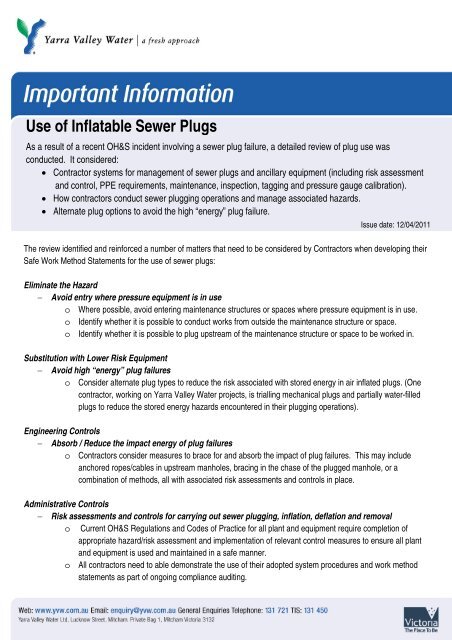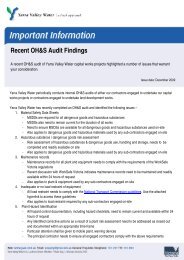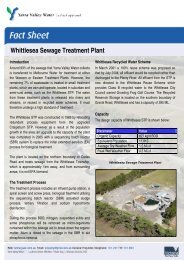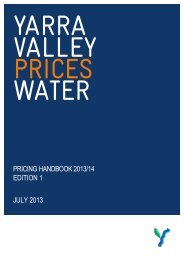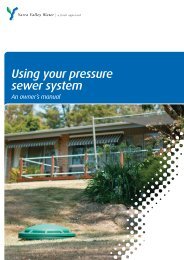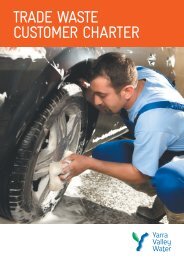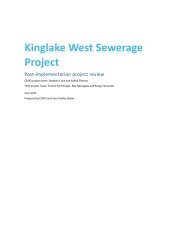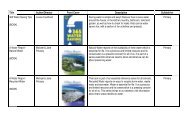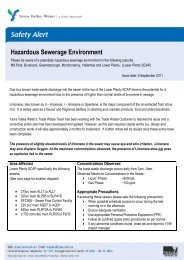Use of Inflatable Sewer Plugs - Yarra Valley Water
Use of Inflatable Sewer Plugs - Yarra Valley Water
Use of Inflatable Sewer Plugs - Yarra Valley Water
Create successful ePaper yourself
Turn your PDF publications into a flip-book with our unique Google optimized e-Paper software.
<strong>Use</strong> <strong>of</strong> <strong>Inflatable</strong> <strong>Sewer</strong> <strong>Plugs</strong>As a result <strong>of</strong> a recent OH&S incident involving a sewer plug failure, a detailed review <strong>of</strong> plug use wasconducted. It considered: Contractor systems for management <strong>of</strong> sewer plugs and ancillary equipment (including risk assessmentand control, PPE requirements, maintenance, inspection, tagging and pressure gauge calibration). How contractors conduct sewer plugging operations and manage associated hazards. Alternate plug options to avoid the high “energy” plug failure.Issue date: 12/04/2011The review identified and reinforced a number <strong>of</strong> matters that need to be considered by Contractors when developing theirSafe Work Method Statements for the use <strong>of</strong> sewer plugs:Eliminate the Hazard Avoid entry where pressure equipment is in useo Where possible, avoid entering maintenance structures or spaces where pressure equipment is in use.o Identify whether it is possible to conduct works from outside the maintenance structure or space.o Identify whether it is possible to plug upstream <strong>of</strong> the maintenance structure or space to be worked in.Substitution with Lower Risk Equipment Avoid high “energy” plug failureso Consider alternate plug types to reduce the risk associated with stored energy in air inflated plugs. (Onecontractor, working on <strong>Yarra</strong> <strong>Valley</strong> <strong>Water</strong> projects, is trialling mechanical plugs and partially water-filledplugs to reduce the stored energy hazards encountered in their plugging operations).Engineering Controls Absorb / Reduce the impact energy <strong>of</strong> plug failureso Contractors consider measures to brace for and absorb the impact <strong>of</strong> plug failures. This may includeanchored ropes/cables in upstream manholes, bracing in the chase <strong>of</strong> the plugged manhole, or acombination <strong>of</strong> methods, all with associated risk assessments and controls in place.Administrative Controls Risk assessments and controls for carrying out sewer plugging, inflation, deflation and removalo Current OH&S Regulations and Codes <strong>of</strong> Practice for all plant and equipment require completion <strong>of</strong>appropriate hazard/risk assessment and implementation <strong>of</strong> relevant control measures to ensure all plantand equipment is used and maintained in a safe manner.o All contractors need to able demonstrate the use <strong>of</strong> their adopted system procedures and work methodstatements as part <strong>of</strong> ongoing compliance auditing.
o Workers must be made aware <strong>of</strong> the inherent risks <strong>of</strong> pressure equipment, adequately trained andconfirmed competent in the use <strong>of</strong> pressure equipment. <strong>Inflatable</strong> plug inspection prior to each use, testing and taggingo Contractors need to ensure that the sewer plug is inspected prior to each use. The plug shall be partiallyinflated and inspected under low pressure for any obvious wear, tear, cuts, abrasions or damage.o <strong>Sewer</strong> plugs need to be subject to a regular testing/inspection regime.o <strong>Plugs</strong> need to be tagged out <strong>of</strong> use if not fit or suitable for purpose or preferably not on the constructionsite. Host pipe inspection prior to each plug useo Contractors need to ensure that the host pipe is inspected prior to each plug use.o The host pipe (which the plug will be inserted into) needs to be inspected to ensure no sharp pipe shards,cement dags, or other protrusions are present that could cause plug damage and / or plug failure. Operating within plug manufacturer designationso Contractors need to consider the maximum safe working hydraulic pressure on a plug, as designated bythe manufacturer, is monitored constantly and not exceeded. Pressure gauge approval, calibration and monitoringo Ensure only the use <strong>of</strong> approved and calibrated pressure gauges.o Ensure pressures are monitored and controlled during plug inflation / deflation with calibrated gauges.o Keep records <strong>of</strong> gauge calibration and have available for audit. Equipment working pressures labelled and documentedo All pressure equipment needs to be adequately labelled and procedurally documented to ensure that safeworking pressures are not exceeded. Minimum PPE requirements for sewer pluggingo Contractors need to risk assess, identify and implement minimum PPE requirements for all work activitiesassociated with sewer plugging.Contractors must work in accordance with current OH&S Regulations and Codes <strong>of</strong> Practice for plant and equipment.For more informationContact Name ............................................ Gary O’ReganTelephone .................................................. (03) 9872 1185Email ...............................................goregan@yvw.com.auImportant Information No................................................ 17


